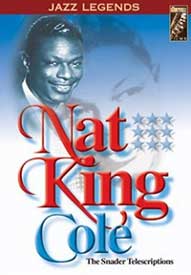 The compilation dvd from the "Swing Era" series, Nat "King" Cole: Soundies & Telescriptions (2004), accumulates twenty-seven soundies, telescriptions, & film clips. There are three clips from Killer Diller (1948) & two from Breakfast in Hollywood (1946), both films preferable in their full context. But the other twenty-two performances are each complete three-minute films.
The compilation dvd from the "Swing Era" series, Nat "King" Cole: Soundies & Telescriptions (2004), accumulates twenty-seven soundies, telescriptions, & film clips. There are three clips from Killer Diller (1948) & two from Breakfast in Hollywood (1946), both films preferable in their full context. But the other twenty-two performances are each complete three-minute films.
The Snader Telescriptions: Nat "King" Cole (199) is a smaller accumulation (fifty-two minutes vs seventy-four) of eighteen telescriptions, without the earlier soundies.
The soundies are from 1945 & 1946, made to play on video jukeboxes. The telescriptions are from 1951, distributed as "filler" for early television, or in some cases sold for "musical review" compilations.
DVD selections of telescriptions & soundies & miscellaneous clips, being public domain material, are generally issued for the "discount market." If they disappear from retailers there will turn up in new packages of the same material, no frills or extras.
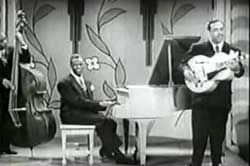 The telescriptions are authentic live performances. The soundies tended to be made in two stages, performers first of all doing the number for microphones to get the sound recording, then playing it again in front of cameras on a stage, playing as near to the same as possible so that the sound recording would match up to the film. The telescriptions are authentic live performances. The soundies tended to be made in two stages, performers first of all doing the number for microphones to get the sound recording, then playing it again in front of cameras on a stage, playing as near to the same as possible so that the sound recording would match up to the film.
While this means the soundies not authentic live performances, the arrangements are sometimes unique to the soundies. Although some performers for the soundies merely lip synced pre-existant records, I don't think this was true for the Nat King Cole Trio.
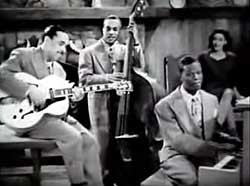 Because the trio became popular a bit late to become important to the soundies era (which in the main had ended by 1946), most of these soundies & telescriptions are in fact Snader Telescriptions, thus significant as live performances, usually quite well recorded. Because the trio became popular a bit late to become important to the soundies era (which in the main had ended by 1946), most of these soundies & telescriptions are in fact Snader Telescriptions, thus significant as live performances, usually quite well recorded.
These represent Nat "King" Cole at his peak because the King Cole Trio had been with him a lot of years perfecting a mood & style that whether truly jazzy or merely poppy was clean, streamlined music -- bass, conga drum or bongos, & guitar -- that supported Nat's vocals & piano playing with beauty & subtlty.
A couple years after the last of these recordings Nat set off on his own as a "mere" pop singer, having bigger musical arrangements, losing the intimacy & art in favor of a slick commercialism. Some good music did come out of this last period of his career as a commercial balladeer, but plainly Nat's golden period was with the trio. These soundies & transcriptions are an ideal way to see them all together in their full glory.
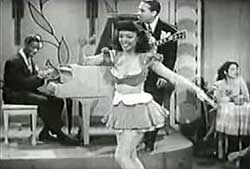 The Nat "King" Cole Trio's Errand Boy for Rhythm (1946) is a jukebox soundie. It's a nice jump-jazz performance reminiscent of Louis Jordan, though Nat's put more jump on the version recorded for the single & soundie is comparativelyh subdued.
The Nat "King" Cole Trio's Errand Boy for Rhythm (1946) is a jukebox soundie. It's a nice jump-jazz performance reminiscent of Louis Jordan, though Nat's put more jump on the version recorded for the single & soundie is comparativelyh subdued.
Charming lyrics evoke Jordan as much as the arrangement of the melody: "You can always find me down in Smokey Joe's/ That's the place where every gal & gator goes/ If you want variety/ Just step in & call for me/ I'm an errand boy for rhythm."
About halfway through the number, a gorgous gal rushes out & dances in a carhop tutu. She's more amusing than skillful as a dancer but she adds a bit of glamour just by looking so cute.
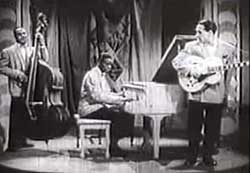 Nat's group was hands-down the best trio of the 1940s. In all his mid to late '40s soundies, his bassist is Johnny Miller, but it will be Joe Comfort on bass in the later Snader telescriptions. Nat's group was hands-down the best trio of the 1940s. In all his mid to late '40s soundies, his bassist is Johnny Miller, but it will be Joe Comfort on bass in the later Snader telescriptions.
His guitarist for the soundies was Oscar Moore, but it will be Irving Ashby playing just as great guitar rifts in the 1951 Snader transcriptions.
Also in the '40s being a "trio" usually counted Nat himself as one of three. But when bongos & conga drummer Jack Costanzo was added it became Nat plus trio.
Got a Penny Benny (1946) is a pleasant piece of pop jazz about being poor: "Got a penny, Benny? Can't ya guess, I haven't any/ And I've got to, got to, call that solid dame/ Got a penny, Benny? Got to telephone Jenny/ And I just got four cents to my name." It's a lot of fun & awfully catchy.
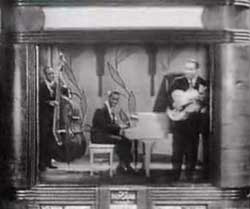 The stage is set up like an intimate cafe for Frim Fram Sauce (1945). The song was written by Redd Evans & Joe Recardel.
The stage is set up like an intimate cafe for Frim Fram Sauce (1945). The song was written by Redd Evans & Joe Recardel.
Although it's got "novelty tune" written all over it, & Nat presents it as a comedy bit, it's nevertheless such a good piece of pop-jazz that it was destined for at least a decade to become a standard with many jazz singers covering it, the most notable a version by Ella Fitzgerald accompanied by Louis Armstrong.
Nat's shown seated alone at a table with four chairs & checkered tablecloth. The seats at the soda fountain are all full, including an amazingly good looking babe who we also saw dancing a bit clutzilly in Errand Boy for Rhythm.
Nat's trying to get the waiter's attention, though he means the soda jerk since there's a waitress rather than a waiter on the floor:
"A fella's really got to eat, & a fella should eat right/ Five will get you ten, I'm gonna feed myself right tonight/ I dont' want fishcakes & rye bread/ You heard what I said/ Waiter, please serve my fries/ I want the frim fram sauce with the aussen fay/ With chafafa on the side."
The nonsense lyrics are coyly about sex, which Nat's glance at the babe at the soda bar telegraphs, especially when he sings "I'm gonna feed myself right tonight." In the cafe itself he never does get served.
In an unexpectedly witty development, for anyone who noticed Nat's band mates are not present, the camera jump-cuts to the cafe's Panoram jukebox, & it's playing this soundie!
There's Nat, Oscar, & Johnny right there on the jukebox video screen. Nat the restaurant customer does a double-take when he sees himself, & the camera cuts back to the Panoram where Nat on the video screen does a doubletake as though he can see himself in the restaurant.
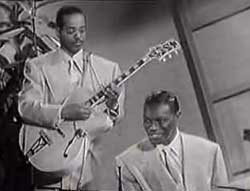 "If you ever plan to motor west/ Travel my way take the highway that's that's the best/ Get your kicks on Route 66." What a great song, & too damned bad there's really no Route 66 anymore!
"If you ever plan to motor west/ Travel my way take the highway that's that's the best/ Get your kicks on Route 66." What a great song, & too damned bad there's really no Route 66 anymore!
Nat King Cole performs this number in the Snader transcription Route 66 (1951), a smooth jazz version of a tune that originated as hipster jive by Harry "the hipster" Gibson, & so adaptable that it would become a rock 'n' role standard by the 1960s.
Nat's take on the song sets the standard, with a lovely electric guitar solo by Irving Ashby into the bargain. Nat plus his trio (guitar, bass, conga drum) really makes you wanna take that journey, even though never again can it be truthfully sung "It winds from Chicago to L.A./ More than 2,000 miles all the way."
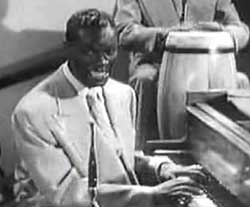 Another telescription recorded the same day with the same set & atmosphere is The Trouble With Me Is You (1951). It's my least favorite in this group of musical films but it's still inescapably a first-rate performance. Another telescription recorded the same day with the same set & atmosphere is The Trouble With Me Is You (1951). It's my least favorite in this group of musical films but it's still inescapably a first-rate performance.
This particular Snader got recycled into the phonied up "concert review" film Showtime at the Apollo: Review in Rhythm (1955), a collection of Snader & Studio Telescriptions featuring performers like Dinah Washington & Duke Ellington & so on, with new footage added with "host" Willie Bryant pretending everyone's there in front of a big audience & on the same night.
The lyrics have some amusing wordplay & a fingersnapping beat. "I'm calling you up, but you're calling me down/ I want you to smile but you give me the frown/ It's easy to see that the trouble with me is you."
As in so many arrangements for Nat & his trio, he gives himself a fine little piano solo, with Ashby on guitar getting a few moments to prove his stuff, too.
These guys can be seen performing a different arrangement of "The Trouble with Me is You" in the somewhat misnomered Rock 'n' Roll Review (1955).
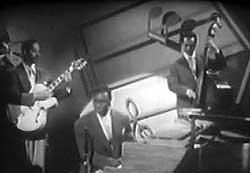 Most of these telescriptions include conga drummer Jack Costanzo to the trio, but he is excuded from You Call It Madness (1951). Most of these telescriptions include conga drummer Jack Costanzo to the trio, but he is excuded from You Call It Madness (1951).
This Snader was recycled into the half-hour pretend-concert Showtime at the Apollo: Showtime in Harlem (1955) "hosted" Willie Bryant who tries to give the impression that it's a live show with Lionel Hampton, The Delta Rhythm Boys, & others, butthe only new material is himself & his comedian pals Mantan Moreland & Nipsey Russell.
Nat is singing the soft jazz ballad with his eternal silkiness; "I can't forget the night I met you/ That's all I'm dreaming of/ But now you call it madness/ But I call it love."
Just as Nat goes into his piano solo, we hear very polite audience clapping, & before the performance began, the camera scanned a large audience. This appearance of taking place before a large audience has gotten this transcription labeled by some as a 1955 performance at the Apollo Theater.
But apart from the loss of the conga drummer, this looks like it must've been filmed the same day, & certainly on the exact same set, as for the Snaders Route 66 & The Trouble with Me is You. So it had to have been canned applause. The Snader recordings are live performances, but did not include audiences.
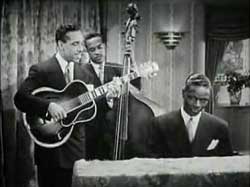 The King Cole Trio, with Nat at the piano, are performing in what looks like an intimate living-room setting, as Nat sings the opening verse for the great Louis Jordan number Is You Is or Is You Aint (My Baby) (1944):
The King Cole Trio, with Nat at the piano, are performing in what looks like an intimate living-room setting, as Nat sings the opening verse for the great Louis Jordan number Is You Is or Is You Aint (My Baby) (1944):
"She's always late/ Anytime we have a date/ But I love her/ Yes I love her/ I'm gonna walk right up to her gate/ See if I can get it straight/ Cuz I want her/ I'm gonna ask her."
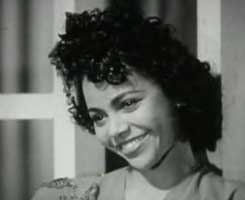 That's the cue for Ida James to sing the chorus: "Is you is or is you ain't my baby/ The way you're acting lately makes me doubt/ Yooz is still my baby baby/ Or has my flame in your heart done gone out/ That's the cue for Ida James to sing the chorus: "Is you is or is you ain't my baby/ The way you're acting lately makes me doubt/ Yooz is still my baby baby/ Or has my flame in your heart done gone out/
"A man is a creature, always been strange/ When you're sure of one you find he's gone & made a change/ So is you is or is you ain't my baby/ Or maybe baby you've found somebody new/ Or is my baby still my baby true."
The trio picks up a rapid instrumental for the break, then Nat & Ida reprise a few closing lines. Ida's absolutely gorgeous with the dearest smile, & she's got a sweet clear voice to match.
For juke box play, this petite gal was in the top-twenty popular vocalists in America of the 1940s & it's a shame her reputation hasn't lasted. She can also be see in the black-cast films The Devil's Daughter (1939) & Hi Di Ho (1947).
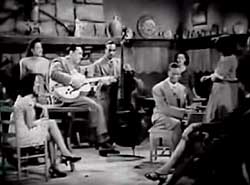 Nat is smiling broadly & looking like he's in an awfully good mood singing a number written by by Inez James & Sidney Miller,Come to Baby Do (1946), on a set dressed up to look like a small club. Nat is smiling broadly & looking like he's in an awfully good mood singing a number written by by Inez James & Sidney Miller,Come to Baby Do (1946), on a set dressed up to look like a small club.
It might be the babes arrayed around the club who've got him lookin' & feelin' so chipper, cuz not one guy showed up for the show.
And every one of those girls look desirous as Nat, backed by Oscar Moore & Johnny Miller, sings a slow-jazz romantic lyric:
"I took a choo-choo fast as I could take a choo-choo/ I've come a long-long-long way to take you in my arms/ And now its your first move to prove that youve been true/ Come to baby, do."
For When I Fall In Love (1951) Nat is standing alone on a simply arranged but dramatic stage, beginning with overhead camera shot that descends to settle on him as the orchestral strings rise. It's immediately aparent that we're in one of the early arrangements without the King Cole Trio, from which Nat would too soon part permanently.
Nat usually gave less brilliant interpretations when he sang with bland orchestral arrangements, especially when he worked with Nelson Riddle or the somewhat less agregious Billy May or Russ Morgan orchestras, & lost all sense of even medium-serious jazz.
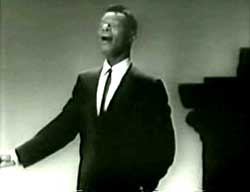 He recorded When I Fall in Love with the Gordon Jenkins Orchestra, noted for overblown string romanticism. But the orchestra is not present on the Snader or they'd've been filmed. Though Nat's singing live, not lip-syncing, the orchestra is nevertheless on reel-to-reel tape. He recorded When I Fall in Love with the Gordon Jenkins Orchestra, noted for overblown string romanticism. But the orchestra is not present on the Snader or they'd've been filmed. Though Nat's singing live, not lip-syncing, the orchestra is nevertheless on reel-to-reel tape.
When I Fall In Love lends full understanding to the recurring discriptions of his voice as "silky" "smooth" "velvet," though in fact if you listen more carefully you'll catch little moments of the raspiness that his heavy smoking lent him, & which got worse as the decade proceded.
Despite that the smoking killed him much too early, that slight raspiness is the thing that keeps him from being so smooth that he might've just slipped away from this world scarcely noticed. Instead he's like an expertly created piece of Zen pottery, with a single flaw that makes him so much better.
To me the violins & harp are just too syrupy & Nat has adjusted his interpretation accordingly. If he were recording these songs today, in this manner, they'd be distributed by Victoria's Secret. As he became less a jazz performer & more commercially pop, he was so romantic that he was marketed chiefly to chubby housewives to play while reading the latest Halrequin Romance & eating stale leaking cherry bonbons.
However, I'm not totally immune to syrup, & when Nat walks closer to the camera seemingly to tell me personally, "In a restless world like this is/ Love is ended before it's begun/ And too many moonlight kisses/ Seem to cool in the warm of the sun," gotta admit the heart catches just a bit. For this Snader, he's throwing himself into the drama of the lyrics in a way he just about never did so few years later on his Nat "King" Cole Show for NBC.
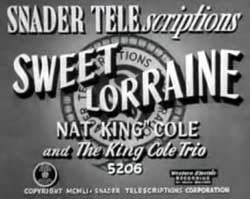 The Snader company averaged six of their three-minute telescriptions a day & some of these little Nat King Cole films were obviously made back to back.
The Snader company averaged six of their three-minute telescriptions a day & some of these little Nat King Cole films were obviously made back to back.
But the set changes from Route 66, The Trouble With Me Is You & You Call It Madness for the filming of slow-dance number Sweet Lorraine (1951), undertaken on another day.
As performed long before by Art Tatum, it had a swifter jazz tempo, but Nat made it a ballad for lovers:
"I've just found joy/ I'm as happy as a baby boy/ With another brand new choo-choo-choy/ When I met my sweet Lorraine.
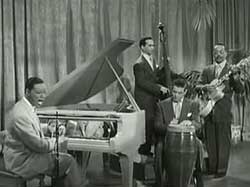 On the same set as Sweet Lorraine, with the same palm & pillar, Nat at piano plus Trio performs the soft ballad Home (1951), about a wanderer's dreams of home: On the same set as Sweet Lorraine, with the same palm & pillar, Nat at piano plus Trio performs the soft ballad Home (1951), about a wanderer's dreams of home:
"When the hills conceal the setting sun/ Stars began a-peeping one by one." I'm not fond of the song or its lyrics, but Nat's too-brief of a piano solo is a nice one.
The set is arranged so that the trio is out of the frame most of the time, replaced by a potted palm & a pillar, which just seems wrong. When it cuts to the second camera set further back, & we see the whole group (Nat plus three), it looks right.
As usual, Nat plays directly to the camera with an intense gaze, until he reaches his piano solo, during which he watches the keys with the same intensity.
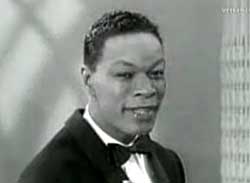 Pop balladeer or jazz great? Nat was both, & the telescription for Mona Lisa (1951) captures him in perfect voice as the balladeer: Pop balladeer or jazz great? Nat was both, & the telescription for Mona Lisa (1951) captures him in perfect voice as the balladeer:
"Do you smile to tempt a lover, Mona Lisa/ Or is this your way to hide a broken heart/ Many dreams have been brought to your doorstep/ They just lie there/ And they die there/ Are you war are your real Mona Lisa/ Or just a cold & lonely lovely work of art."
Once more Jack Costanzo is left out; he's on some of the Snaders but not others, & maybe it's only because some of the arrangements were still being used from before Nat added a percussionist to the "trio" making it a quintet though still called a trio because it was Nat "King" Cole plus the King Cole Trio.
One thing startling about the Snaders is Nat looks a bit swollen in the face. He is so healthy-seeming & beautiful in the 1946 soundies, & he's changelessly gorgeous in the 1957 television show.
But he had in fact recurring health problems (he collapsed on stage at Carnagie Hall in 1953, needing emergency surgery for ulcers). And in the Snaders he definitely looks like he's been through a patch of illness or sleeplessness, or is on some kind of medication that makes him a bit puffy around the eyes.
Fortunately his voice weas unaffected. His voice has been described as silk & honey, butterflies & cream, but in fact there's a little bit of raspiness born of the same cigarette addiction that killed him at forty-six.
And though we may lament how tobacco addiction brought about his early death, got to admit it was that percentage of roughness & imperfection in his voice that made him spectacular, rather than a mere crooner without that something unique. And what a cruel irony if it's true that the addiction that gave him lung cancer was at the same time part of the source of his greatness.
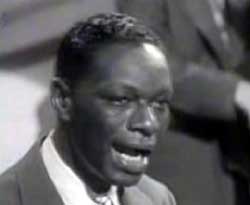 For Sentimental Reasons (1951) was shot the same day as Route 66 & You Call it Madness, all on the same stage with pretty much the same camera angles.
For Sentimental Reasons (1951) was shot the same day as Route 66 & You Call it Madness, all on the same stage with pretty much the same camera angles.
It got spliced into Live at the Apollo (1955) where with similar telescriptions plus newly filmed material with emcee, it pretends to be part of a live show with audience.
The King Cole Trio is sedate for this languid love song. The presence of guitar & doublebass to back Nat's piano & his voice is really everything he needed to give a good interpretation to just such pop songs.
After he ditched the trio in favor of the Nelson Riddle Orchestra, his vocal stylings became as bland as the orchestra. But these live-recorded Snaders show that it was the loss of the intimacy of the Trio that reduced Nat's art even if not his mass popularity later in the '50s & the early '60s.
This Snader ends with the Apollo audience screaming for joy, but of course, Nat was not in front of such an audience.
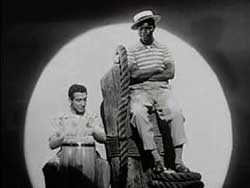 The Snader telescription for Calypso Blues (1951) got spliced into the equally faked Apollo review variously packaged as Rhythm & Blues (1955) & as Showtime at the Apollo: Harlem Variety Review (1955). The Snader telescription for Calypso Blues (1951) got spliced into the equally faked Apollo review variously packaged as Rhythm & Blues (1955) & as Showtime at the Apollo: Harlem Variety Review (1955).
Unlike the earlier soundies which frequently had unusual & elaborate stage settings, most telescriptions were kept simple, just the performance. This one, however, has the look of a soundie.
Calypso Blues comes very close to being an acapella performance, as he's not at his piano, he doesn't have his guitar or doublebass back-up, but he does have Jack Costanzo with him. It's just Nat's voice & Jack's conga drum, & allowing for a twee element to the song, it's a damn good number:
"Me throat she sick from necktie/ My feet she hurt from shoes/ Me pocket full of empty/ I got calypso blues." Perhaps I should feel embarrassed for Nat trying to fake a Carribean accent, but I can't help it, this is one of my two or three favorite Snaders.
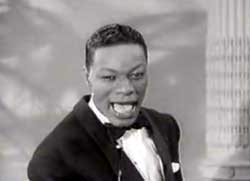 Nat's Snader telescription Nature Boy (1951) captures a live performance that is distinct from his 1948 hit single. It was filmed back-to-back with Mona Lisa without even moving the stationary camera.
Nat's Snader telescription Nature Boy (1951) captures a live performance that is distinct from his 1948 hit single. It was filmed back-to-back with Mona Lisa without even moving the stationary camera.
This is such a strange piece of music it's hard to dismiss it as mere pop, & the arrangement is slow &mp eerie, with a sophistication lacking in many a big pop hit. It just about bridges Nat's musically more advanced jazz performances with the catchy simplicity of his bread & butter pop songs.
When I just think about this song it seems kind of dumb to me. But then every time I hear it I can't help but think Nat really made something of it. The lyric, to be sung by a man for a man, are inescapably homosexual, which is why the term "Nature Boy" came to mean gay after the song if not before, & it was played in all the era's gay bars with jukeboxes.
"There was a boy/ A very strange enchanted boy/ They say he wandered very far/ Very far over land & sea/ A little shy, & sad of eye/ But very wise was he/ And then one day/ A magic day he passed my way/ And while we spoke of many things/ Fools & kings/ This he said to me/ The greatest thing you'll ever learn/ Is just to love & be loved in return." Not a bad lyric, eh?
Composer, poet, & beatnik eden ahbez (he never used capitals in his name) had "borrowed" the tune from Herman Yablakoff's Yiddish music hall tune "Sveig Mein Hartz" ("Be Still My Heart"). Though ahbez sold many songs to many top performers in years to follow, he never really wrote anything else anyone wanted to listen to more than once.
He was the original pre-hippie granola-munching New Age weirdo who slept outdoors, had Jesus Christ's hairdo, was a self-proclaimed yogi who taught "we're cosmic beings," & claimed he could live on three dollars a week.
Honest to shit, if a hippie from Haight-Ashbury Summer of Love went back in time from 1967 to 1947, & encountered ahbez riding his bike or living under the Hollywood sign or playing music for hand-outs in a food co-op, the kid from 1967 would not believe he'd actually changed places in time, ahbez being the complete prototype for a fashion that was twenty years in the future.
For ahbez, being a nature boy really did mean being close to nature or one with the cosmic clown of happiness, man. Still, he had to have known "a very strange enchanted boy" would immediately be coopted as code for gay, & we can hope ahbez was an honestly decent enough guy to have found that perfectly all right.
In the telescription, Nat tries to undermine the gay (or at least nudist colony) intimations by wearing a sunday-school suit & sitting a lot more sedately than usual at his piano. He looks just a little uncomfortable singing such lyrics, as though it had only been mentioned to him that day what it could mean, & he's thinking, oh lord no. But that shows only in his face & body language, not in his voice. And his piano solo is is the best part.
copyright © by Paghat the Ratgirl
|
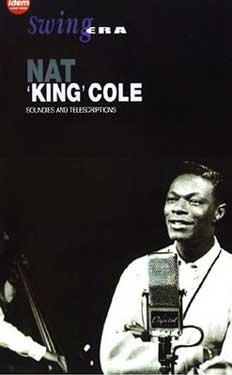

 The telescriptions are authentic live performances. The soundies tended to be made in two stages, performers first of all doing the number for microphones to get the sound recording, then playing it again in front of cameras on a stage, playing as near to the same as possible so that the sound recording would match up to the film.
The telescriptions are authentic live performances. The soundies tended to be made in two stages, performers first of all doing the number for microphones to get the sound recording, then playing it again in front of cameras on a stage, playing as near to the same as possible so that the sound recording would match up to the film. Because the trio became popular a bit late to become important to the soundies era (which in the main had ended by 1946), most of these soundies & telescriptions are in fact Snader Telescriptions, thus significant as live performances, usually quite well recorded.
Because the trio became popular a bit late to become important to the soundies era (which in the main had ended by 1946), most of these soundies & telescriptions are in fact Snader Telescriptions, thus significant as live performances, usually quite well recorded.
 Nat's group was hands-down the best trio of the 1940s. In all his mid to late '40s soundies, his bassist is Johnny Miller, but it will be Joe Comfort on bass in the later Snader telescriptions.
Nat's group was hands-down the best trio of the 1940s. In all his mid to late '40s soundies, his bassist is Johnny Miller, but it will be Joe Comfort on bass in the later Snader telescriptions.

 Another telescription recorded the same day with the same set & atmosphere is The Trouble With Me Is You (1951). It's my least favorite in this group of musical films but it's still inescapably a first-rate performance.
Another telescription recorded the same day with the same set & atmosphere is The Trouble With Me Is You (1951). It's my least favorite in this group of musical films but it's still inescapably a first-rate performance. Most of these telescriptions include conga drummer Jack Costanzo to the trio, but he is excuded from You Call It Madness (1951).
Most of these telescriptions include conga drummer Jack Costanzo to the trio, but he is excuded from You Call It Madness (1951).
 That's the cue for Ida James to sing the chorus: "Is you is or is you ain't my baby/ The way you're acting lately makes me doubt/ Yooz is still my baby baby/ Or has my flame in your heart done gone out/
That's the cue for Ida James to sing the chorus: "Is you is or is you ain't my baby/ The way you're acting lately makes me doubt/ Yooz is still my baby baby/ Or has my flame in your heart done gone out/
 He recorded When I Fall in Love with the Gordon Jenkins Orchestra, noted for overblown string romanticism. But the orchestra is not present on the Snader or they'd've been filmed. Though Nat's singing live, not lip-syncing, the orchestra is nevertheless on reel-to-reel tape.
He recorded When I Fall in Love with the Gordon Jenkins Orchestra, noted for overblown string romanticism. But the orchestra is not present on the Snader or they'd've been filmed. Though Nat's singing live, not lip-syncing, the orchestra is nevertheless on reel-to-reel tape.
 On the same set as Sweet Lorraine, with the same palm & pillar, Nat at piano plus Trio performs the soft ballad Home (1951), about a wanderer's dreams of home:
On the same set as Sweet Lorraine, with the same palm & pillar, Nat at piano plus Trio performs the soft ballad Home (1951), about a wanderer's dreams of home:

 The Snader telescription for Calypso Blues (1951) got spliced into the equally faked Apollo review variously packaged as Rhythm & Blues (1955) & as
The Snader telescription for Calypso Blues (1951) got spliced into the equally faked Apollo review variously packaged as Rhythm & Blues (1955) & as 